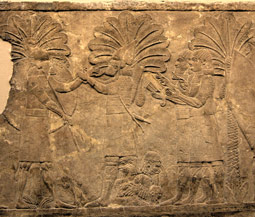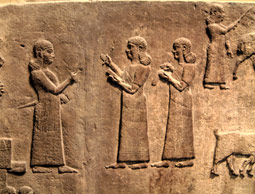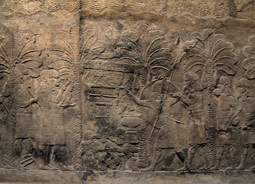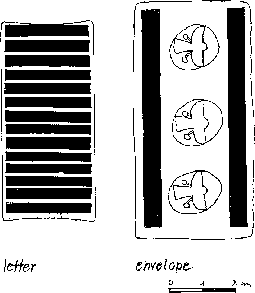Assyrian writing materials: clay tablets, writing-boards and leather scrolls
The development of the cuneiform script cannot be separated from the Mesopotamian technology of writing, for the script owes its unique character to the fact that the signs are composed from the triangular impressions of a reed stylus TT ("wedges"), imprinted into moist clay.
Wax-covered writing-boards

A pair of scribes, one with a writing-board and one with a scroll, filing reports after a successful battle during the Babylonian campaign; detail of the stone decoration of Assurbanipal's Southwest Palace in Nineveh (room XXVIII, panels 9-11, middle register; BM ANE 124955-7). Photo by Eleanor Robson. View large image.
But clay was not the only writing medium available to the Assyrian scribes. While memorial and dedicatory inscriptions were incised in all sorts of materials, including vessels and stone, wooden writing-boards TT played an important role for administrative purposes and library texts. A thin layer of wax was set into a wooden frame and the writing impressed into it with a wooden (or metal) stylus; a reed stylus may have worked too, depending on how malleable the wax layer had been made by adding paraffin. Single leaves are known, but more frequently two leaves were hinged together, creating a double writing-board that could be closed in order to protect the wax surfaces. writing-boards could also consist of several hinged leaves that folded up like an accordion. Luxury versions of such writing-boards were made out of ivory, of which several Assyrian examples have survived in Assur PGP and Calah PGP . One such ivory writing-board from Calah, now on display in the Ashmolean Museum in Oxford, was patiently assembled from its many fragments by Agatha Christie, the creator of the Hercule Poirot and Miss Marple detective novels who, as the wife of archaeologist Max Mallowan, spent many years on excavations in the Near East.
While few ancient writing-boards have survived in the original, Assyrian library records make it clear that the royal library at Nineveh PGP contained them in large quantities. They seem to have been especially popular for lengthy compositions such as the celestial TT omen TT compendium Enuma Anu Enlil TT , which would take dozens of clay tablets and could be far more easily and conveniently stored on a multi-leaved writing-board. Their use in the administration was equally widespread, for different reasons: The fact that, unlike clay, their wax surface did not dry out and was easily erasable added to the attraction of the handy size of these writing tools. Their administrative application is best demonstrated by the frequent depiction on Assyrian palace reliefs. Typically, a pair of scribes is shown registering goods, such as war spoils or tribute delivered to Assyria, or people, often war captives. One of the two scribes is writing in the cuneiform script and the Akkadian language (in the contemporary Assyrian dialect); he is using either a clay tablet or a writing-board.
Leather scrolls and the alphabetic script

A pair of scribes, one with a clay tablet and one with a writing scroll, filing reports after the conquest of a Babylonian city; detail from the stone decoration of Tiglath-pileser III's Central Palace at Nimrud (BM ANE 118882). Photo by Eleanor Robson. View large image.
The other scribe, however, is shown writing with a pen on a leather scroll; he is extremely unlikely to be using the cuneiform script which is quite cumbersome to record on a flat writing surface. This scribe is most certainly depicted writing in the Aramaic language, using an alphabetic script that is closely related to the Phoenician and Greek alphabets from which our own modern writing system ultimately derives. No original leather scrolls have survived from Ancient Assyria, but the frequent references to "Aramaic scribes" illustrate that their services were widely used after this writing system had been introduced to Mesopotamia from the West in the early first millennium BC.
The most popular writing material: clay tablets

A pair of scribes, one with a writing-board and one with a scroll, counting booty after a successful battle during the Babylonian campaign; detail of the stone decoration of Assurbanipal's Southwest Palace in Nineveh court XIX, panel 12; (BM ANE 124825). Photo by Eleanor Robson. View large image.
Yet the most frequent writing material in ancient Mesopotamia remained the ever-present clay, easily sourced from the river banks and inscribed with a stylus, typically fashioned out of the equally ubiquitous reed. The clay was formed into tablets, whose size, shape, and layout was closely associated with their function and content. For instance, it is possible to determine the nature of any legal document purely on the basis of its shape, without reading a single word, as different format types were reserved for specific purposes. This is also true for the materials of the scholarly correspondence of Nineveh. The astrological reports and extispicy queries written to the Assyrian kings are typically of the size and shape of a mobile phone, with the writing running parallel to the long side.
Letters and their envelopes

A letter and its envelope. Drawing by Karen Radner. View large image.
The scholarly letters were often composed by exactly the same men who wrote the reports and queries, using similar sized tablets, but with the script running parallel to the short side. Like modern letters, they were enclosed in an envelope, albeit one made out of a thin layer of clay that was then sealed (and thereby authenticated) with the sender's seal TT . The envelope was also inscribed with the names of the sender and of the recipient and usually a short, formulaic greeting; this information is repeated in the beginning of the letter itself. Very few of these envelopes have survived because in order to read the letter the envelope had to be removed - think of cracking a walnut. Therefore, the only examples of preserved envelopes stem from letters that were never read by their recipients; such letters have, for example, been excavated in the city of Assur, in a private house that was destroyed during the capture of the city in 614 BC before the master of the house, absent on a business trip, had had a chance to read the letters that had been delivered during his absence.
Filing, copying and recycling
Although the documents found in the royal palaces of Nineveh were baked by of the fires of the battle of 612 BC, clay tablets were rarely fired intentionally in antiquity. After their useful life was over they could be recycled by soaking in water, re-used as building rubble, or just thrown away. But important texts like the letters, queries, and reports from the Assyrian royal scholars needed to be archived for reference purposes. For ease of access, they were organised according to content, using the Assyrian variety of filing cabinets: baskets, leather bags and wooden boxes, sometimes with clay filing labels attached. The filing cabinets have not survived the destruction by fire, but the clay tablets and the filing labels remain. Usually only the one original version survives of letters (with the exception of letters written by the king himself of which, at least sometimes, a copy was kept in the royal archives). By contrast, scholarly tablets, such as omen catalogues, medical compendia and rituals TT , were routinely copied when they became old and fragile, in order to preserve the knowledge they contained — but sometimes the scribe had no choice but to write "BREAK" on the new copy where the original had crumbled away.
The clay tablets of the royal archives and libraries survived the destruction of Nineveh in 614 BC, but the other writing materials did not. The wax-covered writing-boards, whether made from wood or ivory, all perished in the flames, just like the leather scrolls and the papyri TT about whose presence in Assyria, alongside Egyptian scribes and scholars, we know only from contemporary accounts. So, although literally tens of thousands of cuneiform tablets survive from Nineveh and the other Neo-Assyrian cities, they represent but a tiny fraction of the written record as it was originally created.
Further reading
- Fales, 'The use and function of Aramaic tablets', 2000
- Radner, 'Format and content', 1995,
- Wiseman, 'Assyrian writing-boards', 1955
Content last modified: 05 Dec 2016.
Karen Radner
Karen Radner, 'Assyrian writing materials: clay tablets, writing-boards and leather scrolls', Knowledge and Power, Higher Education Academy, 2016 [http://oracc.museum.upenn.edu/saao/knpp/essentials/writingmaterials/]